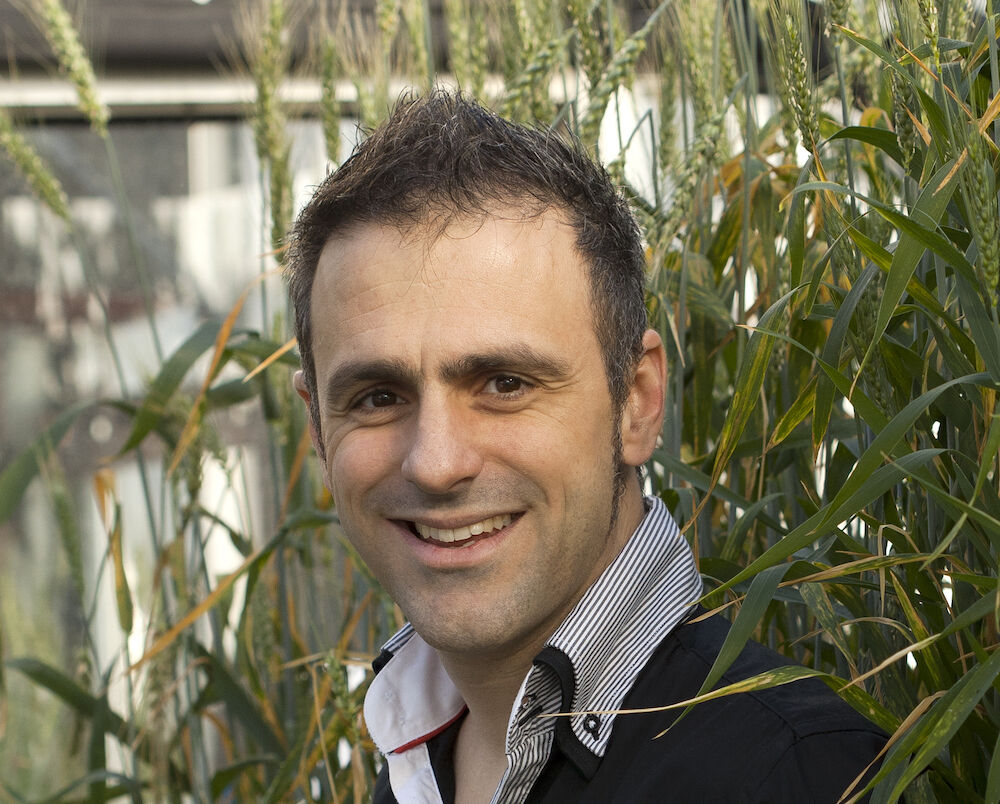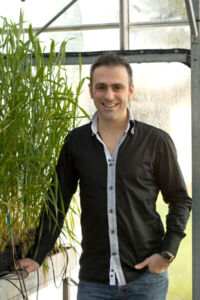Sébastien Praud is a Research Manager at Biogemma , a European plant biotechnology company whose mission is to develop genomic tools and markers and to create new genetic variability to support the breeding programs of its shareholding companies – seed companies and field crop producers.
Sébastien leads the “Genetics and Genomics in Cereals” team. He manages collaborative projects with institutes, universities and competitors, as well as in-house applied projects to deliver knowledge and tools that can be used by Biogemma shareholding companies in their genetic improvement programs.
Sébastien and his team carry out a large range of corn and wheat studies from agronomy and phenotyping to genetic and genomics analyses used for dissecting complex traits and stress response mechanisms, such as drought tolerance and nitrogen utilization in cereals.
Biogemma was an early supporter of the IWGSC and became the second industry sponsor in 2008. Sébastien has represented Biogemma on the Coordinating Committee since 2008.
We caught up with Sébastien in sunny San Diego at the busy PAG meeting to get his views on the current IWGSC developments and the future of the Consortium.
What are the benefits of been part of an International Consortium?
For a private company such as Biogemma, being a part of a consortium that involves prominent scientists from various research groups enables us to have early access to valuable resources we can use in our ongoing projects, to find interesting ideas, and to contribute to the development of innovative projects. Participating in the Coordinating Committee and being able to influence strategic decisions is also a strong advantage.
Moreover, by participating in the IWGSC, Biogemma has increased its international visibility and this, in turn, facilitated the establishment of valuable collaborations.
And let’s not forget the human aspect of the adventure as I still fondly remember the early days where we were 10 around the table and joking about being Knights of the Round Table!
In 2014, the IWGSC released the chromosomes survey sequence, a work in part funded by Biogemma
This was a big step; we finally had something, albeit not perfect, that allowed us to start working on identifying candidate genes in our QTLs.
What else is needed?
Our genetic research, and more precisely gene discovery and native traits development, would greatly benefit from the completion of a gold standard quality reference sequence. We are currently using a chimeric and approximate wheat genome assembly developed from the genome zipper anchored to genetic maps. It is useful but very incomplete. We are waiting for a high quality reference sequence, in which contigs are precisely ordered and positioned, to better anchor our QTLs and find the underlying genes - including candidate genes linked to important traits.
This will allow a lot of applications that are impossible or difficult to develop now – precise LD mapping, powerful gene editing strategy, de novo sequencing of more elite material, easier fine mapping.
This is an international priority that requires international support.
The IWGSC just announced [in January 2016 at PAG] that a reference sequence would be available as early as 2017
This is exciting news. There’s still work needed to integrate all the data generated by the Consortium to release an ordered, reference sequence anchored to the genetic maps, but the end is in sight.
One of the big challenges in our research is to link genotype to phenotype in order to evaluate the alleles segregating in the material and to find genes to develop perfect markers. However, especially in wheat, there is still very imprecise knowledge and understanding of the genes that underlie desirable agronomic traits. Based on our experience in corn, we really think that having access to a complete high quality genome sequence that is ordered and anchored to genetic maps will allow us to quickly link phenotypes to the sequence, to delimitate QTL to certain regions, and to identify underlying genes responsible for traits.
Is the quality of the first reference sequence released an issue for you?
For those of us who have links and collaborations with the scientific community, the priority is to have access to a first version of a reference sequence as early as possible. It might not be perfect, there might be errors or imprecise annotation, but that will allow us to start working. Then, when a new version comes along, we can decide if we need to use it or not. This was the case with corn, the first version, released in 2008, was quite imperfect but still allowed us to make major advances, and we will be using the fourth version of corn that will be released soon.
Why is it so important to have a reference sequence of high quality?
We focus our work on improving throughput and precision of phenotyping to decipher genes involved in complex traits, such as yield. Having a good quality reference sequence is key to doing that. It will also allow us to identify more easily genes of interest that could be used in transgenesis. Moreover, with a good quality genome sequence we could start looking at applying new breeding technologies, such as gene editing, to agricultural traits of interests for breeders and ultimately growers. With gene editing we will be able to choose a mutation or a variant having a positive effect on a trait and to introduce it in a variety more rapidly and with better precision than with current breeding techniques.
We are ready, and fortunately, we will have a first version of a high quality genome in the next months.
How will you translate the reference sequence into applications in the field?
Chinese Spring is an important variety for the reference sequence, but is not a variety that European growers use; we still need the sequence of varieties grown in the field. Having a reference sequence will allow us to do that faster and at a lower price.
The Chinese Spring reference sequence will give us a backbone on which to work, but we will still need to sequence elite varieties to fine-tune our gene discovery program. We might have to sequence only QTL regions of our elite varieties and use the Chinese Spring reference sequence to reconstruct rapidly the whole genome of the elite variety.
Ultimately, we envision that it will become easier and faster to better understand the allelic variations present in our populations and to develop more appropriate tools to help breeders.
How do you see the future of the IWGSC?
For us, European seed breeders, the adventure is not completely finished. We see a role for the IWGSC to coordinate sequencing activities for commercially used wheat cultivars.
Because of the cost of current techniques and due to the wheat genome size and complexity, at our level, we will only be able to sequence elite varieties at a low coverage. It would make sense to have a coordinated effort to sequence at a high quality a few elite varieties, ideally representing the diversity of genotypes worldwide, including some European varieties.
The IWGSC legacy makes it the ideal candidate to coordinate and federate funding to carry out this work.
About Sébastien
After dabbling in Maths and Physics, Sébastien obtained a Master in Biochemistry and Plant Biotechnology before joining Biogemma in 2003, first for an internship on corn transgenesis, then as research scientist to develop genomics and genetics projects in wheat. In 2008, he became Research Manager and joined Biogemma Executive Committee. Sébastien has been involved, as an active partner or coordinator, in several French and European large-scale collaborative projects.
In 2011, he obtained his “accreditation to supervise research” allowing him to supervise PhD students. Educating and transmitting knowledge is one of Sebastien’s passions; for him, participating in the training of new scientists is beneficial at several levels as his team can benefit from new skills and ideas and he can communicate his passion for research on wheat and attract new enthusiastic scientists to the field.
Publication date: 02/08/2016


